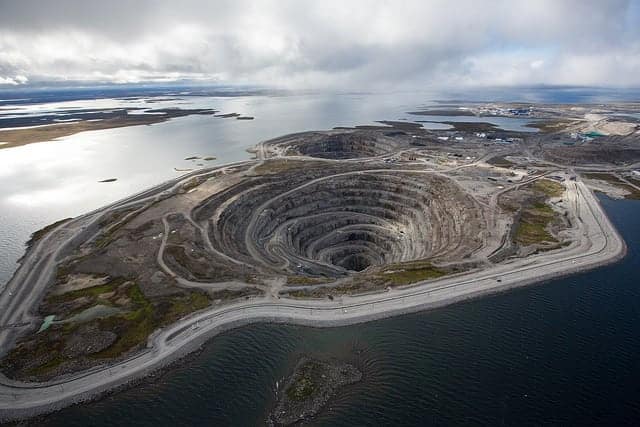If unchanged, a Diavik Diamond Mine plan leaving processed waste rock in used pits would have adverse effects on the nearby lake and its use by First Nations.
The Mackenzie Valley Environmental Impact Review Board stated as much in a decision released this month. The plan can advance to approval, but Diavik must meet six conditions first.
The mine says it is in dire need of more storage — it will run out of space for processed kimberlite, the rock containing diamonds, in 2021. That’s four years before the mine is expected to close.
The plan is to bury waste in one or more pits at the diamond mine on East Island in Lac de Gras, 300 kilometres northeast of Yellowknife, then flood them with freshwater from the lake.
Once these new pit lakes have been tested and are determined to be safe, dike walls separating them from Lac de Gras will be destroyed to allow fish and other creatures pass through freely.
The review board ruled that Diavik will have to take steps to update the water quality modelling it plans to apply to those pit lakes (including forming an independent review panel in order to "improve updated modelling").
That includes collaboratively developing criteria to measure whether the water will be acceptable for cultural use, while conducting more engagement with the affected First Nations.
Finally, the mine will have to "develop community-specific indicators of well-being and adaptively manage project-specific and cumulative impacts on cultural use of Lac de Gras."

The pit lake plan is contentious to some Indigenous groups concerned about being able to continue to use the area for cultural purposes.
Lac de Gras is in the traditional territories of the Tlicho, Yellowknives Dene First Nation (YKDFN), Lutsel K’e First Nation, Deninu Kue First Nation, Fort Resolution Metis Council, North Slave Metis Alliance, Northwest Territories Métis Nation and Kitikmeot Inuit Association.
Edward Sangris, YKDFN chief, qualifying that he hadn’t completely read the roughly 130-page final decision, offered his initial response.
“The decision doesn’t sit well,” he said.
The matter went through the First Nation’s Elders Senate, he said, which expressed its discomfort with storing processed kimberlite so close to the water. Sangris also noted the original plans never called to store processed kimberlite in the pits.
When that changed, there was little notice.
“We weren’t consulted until the last minute until they went to the board to ask to put it underground,” he said.

Nick Pearce/NNSL photo
A spokesperson for Diavik, meanwhile, welcomed the decision. The company took the unusual step of requesting the individual speaking on their behalf not be named.
According to the spokesperson, storing processed kimberlite in mine pits is a common practice in NWT and the proposed measures will ensure safety and environmental responsibility.
“Diavik supports and will implement the measures recommended by the board, which are aligned with actions we have proposed,” stated the spokesperson.
Salt water will exude from the waste rock as the heavier sediment the slurry contains settles to the bottom. When mining at the site concludes, the mine will fill the pits with water from Lac de Gras. Diavik said this fresh water will sit in a layer on top of the saline water below.
In its proposed plan to the Board, the mine stated that the top 40 metres of the water will meet water quality standards, and not adversely affect fish in the lake – a prediction Fisheries and Oceans Canada backed up, according to the board.
North Slave Metis Alliance and Deninu Kue First Nation disagreed in submissions to the board, unconvinced at the toxicity predictions and saying they believe fish may swim deeper than 40 metres.
Indigenous groups are uncertain of the project, according to the board’s decision, because “Diavik has not properly assessed or mitigated" the potential for impacts on cultural use.
“It is also because Diavik did not develop appropriate standards to judge if the water quality in Lac de Gras will be suitable for cultural uses,” it stated.